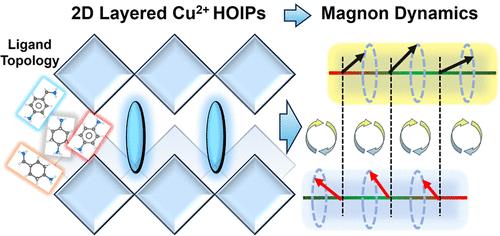通过调整配体拓扑结构将Dion-Jacobson Cu(II)-杂化钙钛矿中的磁振子-磁振子耦合强度提高到0.6 GHz
IF 15.6
1区 化学
Q1 CHEMISTRY, MULTIDISCIPLINARY
引用次数: 0
摘要
铜(II)杂化有机-无机钙钛矿(HOIPs)提供了一个独特的平台来探索导致铁或反铁磁秩序的磁相互作用;然而,它们在相干磁振子动力学(自旋电子技术的基石)方面的潜力仍然不发达。与传统的铁磁体不同,影响HOIPs中磁振子产生、传播和控制的结构参数尚不清楚。在这里,我们设计了基于a型Dion-Jacobson (DJ)相Cu(II)的hoip中的层间和层内交换相互作用,以实现稳健的磁振子-磁振子耦合。通过结合短的平面有机配体,我们实现了0.6 GHz的耦合强度,这是对动态自旋波操纵至关重要的强相互作用的标志。Landau-Lifshitz-Gilbert模拟和密度泛函理论(DFT)表明,层间反铁磁交换和层内易平面各向异性共同决定了Cu(II)-卤化物hoip的耦合强度。这项工作证明了有机配体拓扑结构如何可以战略性地定制以调制磁交换途径,从而能够精确控制自旋波现象。本文章由计算机程序翻译,如有差异,请以英文原文为准。

Enhancing Magnon–Magnon Coupling Strength to 0.6 GHz in Dion–Jacobson Cu(II)-Hybrid Perovskites by Tuning the Topology of Ligands
Copper(II) hybrid organic–inorganic perovskites (HOIPs) offer a unique platform to explore magnetic interactions responsible for ferro- or antiferromagnetic order; yet, their potential for coherent magnon dynamics, a cornerstone of spintronic technologies, remains underdeveloped. Unlike conventional ferromagnets, the structural parameters influencing magnon generation, propagation, and control in HOIPs are poorly understood. Here, we engineer interlayer and intralayer exchange interactions in A-type Dion–Jacobson (DJ) phase Cu(II)-based HOIPs to achieve robust magnon–magnon coupling. By incorporating short, planar organic ligands, we realize a coupling strength of 0.6 GHz, a hallmark of strong interactions vital for dynamic spin-wave manipulation. Landau–Lifshitz–Gilbert simulations and density functional theory (DFT) reveal that interlayer antiferromagnetic exchange and intralayer easy-plane anisotropy jointly dictate the coupling strength in Cu(II)-halide HOIPs. This work demonstrates how the organic ligand topology can be strategically tailored to modulate magnetic exchange pathways, enabling precise control over spin-wave phenomena.
求助全文
通过发布文献求助,成功后即可免费获取论文全文。
去求助
来源期刊
CiteScore
24.40
自引率
6.00%
发文量
2398
审稿时长
1.6 months
期刊介绍:
The flagship journal of the American Chemical Society, known as the Journal of the American Chemical Society (JACS), has been a prestigious publication since its establishment in 1879. It holds a preeminent position in the field of chemistry and related interdisciplinary sciences. JACS is committed to disseminating cutting-edge research papers, covering a wide range of topics, and encompasses approximately 19,000 pages of Articles, Communications, and Perspectives annually. With a weekly publication frequency, JACS plays a vital role in advancing the field of chemistry by providing essential research.

 求助内容:
求助内容: 应助结果提醒方式:
应助结果提醒方式:


